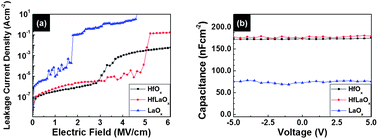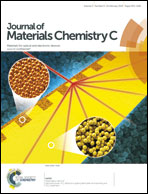Solution-processed amorphous hafnium-lanthanum oxide gate insulator for oxide thin-film transistors†
Abstract
Solution-processed high-K dielectrics for oxide thin-film transistors (TFTs) have been widely studied with the objective of achieving high performance and low-cost TFTs for next-generation displays. In this study, we introduce an amorphous hafnium-lanthanum oxide (HfLaOx) gate insulator with high electrical permittivity which was fabricated by the simple spin-coating method. In particular, the solution-processed HfLaOx dielectric layer, which was achieved by a mixture of two Hf and La metal hydroxide precursors, showed amorphous properties, a low leakage current and a high dielectric constant. The solution-processed HfLaOx dielectric layers showed a breakdown voltage as high as 5 MV cm−1 in strength and a dielectric constant above 22. Based on their implementation as a gate insulator, the solution-processed ZnO/HfLaOx TFTs showed good and stable performances during operation at a low voltage. A mobility of μ = 1.6 cm2 V−1 s−1, an on/off current ratio of 106, and a threshold voltage of 0.0015 V were obtained under a 5 V gate bias. Our results show the possibility of the solution-processed amorphous HfLaOx dielectric layer as a gate insulator for oxide TFTs. We believe that this amorphous HfLaOx dielectric has good potential for next-generation high-performance TFT devices.


 Please wait while we load your content...
Please wait while we load your content...